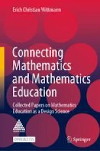- About MAA
- Membership
- MAA Publications
- Periodicals
- Blogs
- MAA Book Series
- MAA Press (an imprint of the AMS)
- MAA Notes
- MAA Reviews
- Mathematical Communication
- Information for Libraries
- Author Resources
- Advertise with MAA
- Meetings
- Competitions
- Programs
- Communities
- MAA Sections
- SIGMAA
- MAA Connect
- Students
- MAA Awards
- Awards Booklets
- Writing Awards
- Teaching Awards
- Service Awards
- Research Awards
- Lecture Awards
- Putnam Competition Individual and Team Winners
- D. E. Shaw Group AMC 8 Awards & Certificates
- Maryam Mirzakhani AMC 10 A Awards & Certificates
- Two Sigma AMC 10 B Awards & Certificates
- Jane Street AMC 12 A Awards & Certificates
- Akamai AMC 12 B Awards & Certificates
- High School Teachers
- News
You are here
Connecting Mathematics and Mathematics Education

Publisher:
Springer
Publication Date:
2020
Number of Pages:
338
Format:
Hardcover
Price:
59.99
ISBN:
978-3-030-61569-7
Category:
Monograph
[Reviewed by , on ]
Deborah Gochenaur
03/20/2023
This collection of papers strives to support mathematics education as a design science in the area of representations in primary classrooms, supporting mathematics education as an autonomous, interdisciplinary, well-established discipline. The goal is to consider mathematics and mathematics education intertwined, including the historical development of mathematical discoveries. This book would be most enjoyed by those who like to read and learn about the development of mathematics education in other countries as well as those who enjoy the historical development of mathematical ideas.
Chapters are a compilation of the author’s foremost papers on the topic. The articles are offered in chronological order, hoping that the reader benefits from the historical development of topics, one upon the other; this means that readers need to refer to the Preface (pg. ix) to read articles within a single category of the following: methodological framework of the approach and as a systemic evolutionary design science, main method for designing learning environments, teacher education, and non-symbolic means of representation.
In general, this book is dense and not light reading. It provides a great deal of information and ideas that readers will need to spend time pondering; much of it will be of interest to those who enjoy learning about the historical development of topics in another culture. The author works to show the development of design science from its development in the early 1970s. He then strives to integrate his work into applications of the research from Mathe 2000, a developmental research project aimed at supporting mathematics education at the primary level, turning theoretical concepts into viable practical materials for primary teachers. Sadly, the referenced materials are all from work prior to 1987 meaning that none of the most recent worldwide research in mathematics education is considered except for the references to the Mathe 2000. While a historical look at non-symbolic representations is important, the lack of reference to work from the past 20 years is a major flaw.
The reviewer: Dr. Deborah Gochenaur is an Associate Professor at Shippensburg University in Pennsylvania with a B.S. in Mathematics from Penn State Harrisburg and a M.S. in Mathematics from Shippensburg University, and a Ph.D. in Mathematics Education for American University. She is an active member of mathematics and mathematics education organizations, serving on state and national committees.
See the publisher's website.
- Log in to post comments




